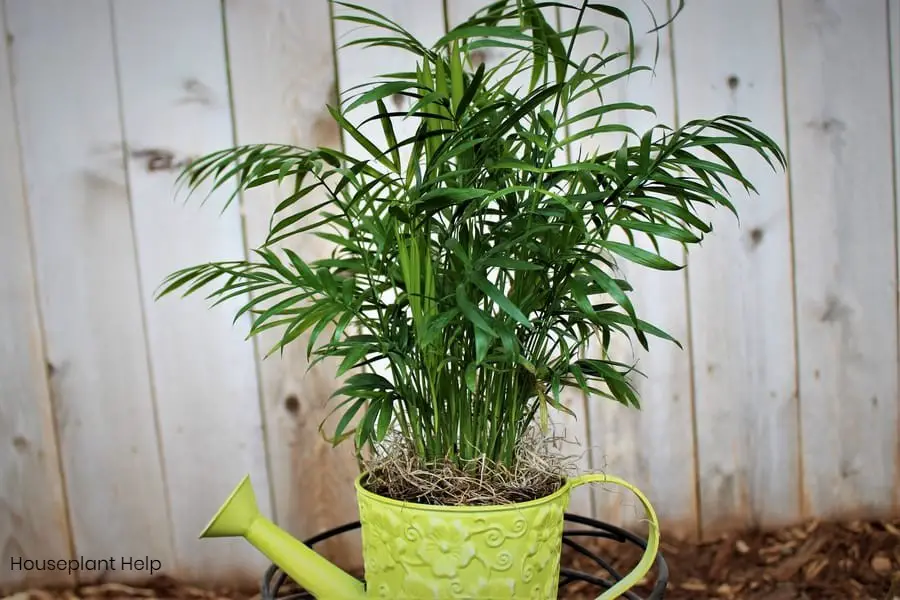
When we decided to buy a new indoor palm tree for our living room, we couldn’t decide between the cat palm or the majesty palm. They’re both beautiful houseplants, but we wanted something that was easy to take care of and had a good chance of success.
So, which one is better – cat palm or majesty palm? As a houseplant, the cat palm is the clear winner. Majesty palm is more difficult to keep healthy indoors and the stress often causes yellowing leaves and a declining appearance. Plus, it’s more prone to pests like spider mites. Cat palm, on the other hand, thrives indoors under the right conditions.
Let’s compare these two palms so you can make an informed decision, and I’ll explain why we chose the cat palm over the majesty.
Indoor Care Difficulty
The cat palm is one of the hardiest and easiest palm trees to grow indoors. It’s part of the graceful parlor palm (Chamaedorea) species, named for their use in Victorian parlors. With bright indirect light and evenly moist soil, this palm will thrive without a lot of fuss.
All parlor palms make great houseplants – hence the common name of the species. Other types include the Neanthe palm, Bamboo palm, and Grass-leafed parlor palm.
The majesty palm, on the other hand, requires very bright light or full sun, lots of water, regular misting, and heavy feeding. Commonly grown outdoors in tropical climates, the majesty palm is truly majestic – but only if its care requirements are met. And this is difficult to achieve indoors.
Without proper care, the majesty palm develops yellow and withered leaves, brown leaf tips, or just loses its leaves completely. Without adequate moisture and humidity, the plant will shrivel and die. The same can be said for cat palm of course, but it’s easier to keep healthy as a houseplant.
It’s not impossible to grown majesty palm indoors, but it’s not for beginners. If you’re looking for an easy-to-grow palm, we recommend a parlor palm (like cat palm) instead. Unless you’re looking for a challenge – then majesty is a great choice.
Cat Palm: 1
Majesty Palm: 0
Pests and Diseases
Diseases rarely affect these plants, but both cat palms and majesty palms are susceptible to spider mites if humidity drops too low. It’s anecdotal, but many houseplant growers I’ve spoken with over the years have observed the problem more often in majesty palm than other types of indoor palms.
Because majesty palms need more frequent watering and high humidity, it’s easier to accidentally let them dry out. Spider mites prefer dry conditions and can infest the dry fronds when the humidity is too low. You may need to mist the fronds every two to three days to keep humidity high enough.
If majesty palm does become infested by spider mites, take it outdoors and spray it down with a hose to remove the pests. Spraying with warm, soapy water every few weeks can also help prevent infestation.
We gave cat palm the point in this category, because it usually doesn’t require frequent misting to prevent spider mites – even though it’s susceptible too. A humidifier placed near majesty palm can prevent the need for misting, so it’s nearly a tie.
But the anecdotal evidence that majesty palms attract mites more frequently pushed us over the edge toward cat palm.
Cat Palm: 2
Majesty Palm: 0
Growth and Size Indoors
As a houseplant, the cat palm can grow four to six feet tall – creating a beautiful display for corridors, entryways, or parlors and sitting rooms. This plant makes a lovely decoration in a sunny corner at its peak height without being too large or overwhelming.
Most indoor palms grow slowly, including the cat palm. It adapts well to container growing indoors and won’t need to be repotted frequently.
The majesty palm can grow to over 18 feet tall when given a large enough pot. Outdoors, it’s a huge tree that can reach heights of over 80 feet. Majesty grows quickly compared to most other indoor palms. However, restricting pot size can help keep it a manageable height.
Since the cat palm doesn’t reach heights greater than our ceilings, we gave it the point for growth and size.
Cat Palm: 3
Majesty Palm: 0
Ultimate Decision
We decided on the cat palm instead of the majesty. Both are beautiful houseplants, but when compared, the cat palm came out ahead for these reasons:
- Easier to care for indoors
- Less prone to spider mites and other pests
- Slower, more manageable growth
In the areas of care difficulty, pests, and growth, cat palm scored 3 and majesty palm scored 0. There’s really no contest. Unless you’re a skilled, experienced grower looking for a challenge, we recommend cat palm or any of the other easy-to-grow parlor palms over the majesty.
Cat Palm!
Are you ready to add a parlor palm to your houseplant collection?
We bought our cat palm from Amazon, and we were so pleased with what we received. You can find some really amazing deals on various parlor palms by shopping online. Click here to see what’s available right now on Amazon.
Related Questions
Is cat palm a good indoor plant? Yes, the cat palm makes a great indoor houseplant. It’s easy to care for – only requiring bright light, moderate to high humidity, and evenly moist soil with occasional feedings. It has a wide spread and grows up to six feet tall, making it a good choice for large spaces. Plus, it’s a great air purifier.
What are some benefits of cat palms? These lovely houseplants purify the air, are easy to grow (even for beginners), adapt well to indoor conditions, and are nontoxic for cats and dogs. They live for many years with proper care. And best of all, they can give any area in your home a tropical feel – especially large, empty corners that get plenty of sun.



